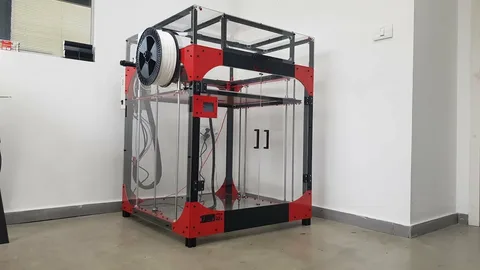Large-scale 3D printing has become an influential technology in both business and consumer sectors. The advancements in 3D printing technologies have expanded the possibilities of creating complex objects at larger sizes, opening new doors for innovation. Industries across the globe are realizing the enormous potential of these technologies for a wide range of applications. From architecture to manufacturing, large-scale 3D printing is helping companies reduce costs, accelerate production processes, and improve overall design flexibility.
This cutting-edge technology is no longer just a buzzword. It’s transforming the way products are conceived, designed, and created. As businesses seek more efficient ways to produce goods and services, large-scale 3D printing offers an innovative solution that can address both economic and environmental challenges. This article explores the profound benefits of this technology for both businesses and consumers, highlighting its growing influence on multiple industries.
Cost-Effective Manufacturing Solutions for Businesses
One of the most significant benefits of large-scale 3D printing is its ability to significantly reduce manufacturing costs. Traditional manufacturing processes often require expensive molds, tooling, and labor-intensive setups. With 3D printing, businesses can produce complex products with minimal resources, saving both time and money. This technology eliminates the need for costly molds or custom tooling, which can be especially beneficial for small and medium-sized enterprises (SMEs) that may not have the capital for large-scale production runs.
Furthermore, large-scale 3D printing allows for rapid prototyping and iteration, reducing the costs associated with product development. Businesses can test multiple iterations of a design before committing to a final version, ultimately leading to better product quality and less waste. This flexibility in the design phase can be a game-changer for industries where time-to-market is critical, such as automotive, aerospace, and consumer electronics. By embracing large-scale 3D printing, companies can streamline their manufacturing processes and achieve greater cost efficiency.
Faster Production and Time-to-Market
In today’s competitive market, speed is everything. Large-scale 3D printing allows businesses to expedite the production process, cutting down on the time it takes to move from concept to finished product. Traditional manufacturing methods can take weeks or even months to set up and produce a single batch of products, but 3D printing can create large objects in a matter of hours or days, depending on the complexity and size. This speed is especially important in industries that demand rapid turnaround times, such as fashion, medical devices, and consumer products.
The ability to quickly produce prototypes and small batches of products allows businesses to test the market and adjust designs based on customer feedback. This agility not only reduces the time to market but also helps companies stay ahead of the competition. The faster a business can bring its products to consumers, the more likely it is to secure a foothold in the market. By utilizing large-scale 3D printing, businesses can gain a significant edge by improving their production timelines, ultimately leading to a faster, more efficient supply chain.
Sustainability and Reduced Waste
Sustainability is an ever-growing concern in today’s world, and large-scale 3D printing is helping businesses reduce their environmental footprint. Unlike traditional manufacturing methods that often involve subtractive processes (e.g., cutting, milling), which can result in significant material waste, 3D printing uses an additive process, where material is deposited layer by layer only where it’s needed. This results in far less waste compared to traditional methods. Additionally, 3D printing allows for the use of recycled materials, further reducing the environmental impact.
For businesses committed to sustainability, large-scale 3D printing offers a powerful tool to create more eco-friendly products. Industries such as automotive, construction, and consumer goods are increasingly incorporating 3D printing into their production processes to reduce material waste and energy consumption. By reducing the need for excess raw materials and minimizing waste, businesses can cut down on both production costs and environmental impact, contributing to a greener future. This not only helps the planet but can also improve a company’s reputation with environmentally conscious consumers.
Customization and Personalization for Consumers
One of the most exciting aspects of large-scale 3D printing is its ability to create highly customized and personalized products. Traditional manufacturing methods often involve mass production, which can be limiting when consumers are seeking unique or personalized items. However, with 3D printing, businesses can easily customize products to meet the specific needs or preferences of individual consumers. Whether it’s custom-fit footwear, personalized jewelry, or tailored medical devices, large-scale 3D printing enables businesses to offer a level of personalization that was previously difficult or impossible to achieve.
Consumers benefit greatly from this level of customization. In industries like healthcare, large-scale 3D printing allows for the creation of personalized medical devices, such as implants, prosthetics, and orthotics, that are tailored to an individual’s anatomy. In the fashion industry, designers can create bespoke garments and accessories that are perfectly suited to the consumer’s taste and measurements. This level of personalization enhances the overall consumer experience and can lead to increased customer loyalty and satisfaction. Large-scale 3D printing is helping businesses deliver products that meet the growing demand for uniqueness and individuality.
Enhanced Innovation and New Business Models
Large-scale 3D printing is a catalyst for innovation, enabling businesses to experiment with new designs, materials, and manufacturing methods that were once considered impractical. The ability to produce complex geometries and intricate designs that are difficult to achieve with traditional manufacturing processes allows businesses to explore creative possibilities and push the boundaries of product development. This has opened up entirely new industries and business models, from 3D-printed houses to on-demand manufacturing services.
Consumers also benefit from the innovation that large-scale 3D printing fosters. The creation of innovative products and designs leads to the availability of new goods that are more functional, aesthetically pleasing, or better suited to consumers’ evolving needs. Additionally, businesses can leverage 3D printing to develop new service models, such as on-demand or subscription-based manufacturing, where consumers can order customized products directly from the manufacturer. This disruptive approach to business and product development is reshaping industries and offering exciting new opportunities for both businesses and consumers.
Conclusion
Large-scale 3D printing is already having a profound impact on both businesses and consumers, and its potential is far from being fully realized. As technology continues to advance, we can expect even more efficient, sustainable, and innovative solutions to emerge. For businesses, the ability to reduce costs, accelerate production, and create customized products offers a clear competitive advantage. For consumers, the opportunities for personalized, high-quality goods are expanding rapidly.
The future of large-scale 3D printing holds exciting prospects. As industries continue to embrace this technology, we will likely see even more creative applications, pushing the boundaries of what is possible in manufacturing and product development. The integration of 3D printing into mainstream production processes is poised to revolutionize the way we think about manufacturing, customization, and sustainability, creating a more efficient, innovative, and personalized world for businesses and consumers alike.











Leave a Reply